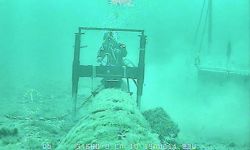Turtles return, 10 years after Kalamazoo River oil spill

LANSING –The turtles had a long journey ahead.
They fought for 45 miles against the strong Kalamazoo River current. They left the river and walked up and over a dam blocking their path. They traversed water so shallow their shells likely stuck out of it.
The destination? Their home 10 years earlier until the 2010 Kalamazoo River oil spill near Marshall wiped it out.
In July 2010, one of the largest U.S. inland oil spills struck when an Enbridge pipeline burst, sending an estimated 4.5 million gallons of oil into Talmadge Creek, a Kalamazoo River tributary.
Related:
- Michigan deer harvest numbers are down: How did your county do?
- Lawsuit could complicate drone laws for Michigan hunters and anglers
- Supreme Court poop dispute could have big impact on Michigan environment
It resulted in one of the largest inland oil spills in U.S. history.
As part of an emergency wildlife rescue effort, the Department of Natural Resources and the U.S. Fish and Wildlife Service relocated more than 700 northern map turtles to similar habitats along the Kalamazoo River.
In the decade following the spill, researchers led by Joshua Otten, a research ecologist with the University of Toledo, studied the movements of the map turtles after being relocated. A recent study in the journal Conservation Science and Practice details the initial emergency move and the turtles’ subsequent movements for those years.
“The oil spill was a tragedy. But scientifically? It was an incredible opportunity to learn exactly how far these turtles will go,” said Stephen Hamilton, an aquatic ecosystem ecologist and biogeochemist with Michigan State University’s W.K. Kellogg Biological Station in South Gull Lake, near Kalamazoo.
“We had no idea how far freshwater turtles could travel,” Hamilton said.
The turtles used their homing instincts to find their way back to their nests.
Otten and his team expected that possibility. What they did not expect was the turtles traveling almost 45 miles upstream.
“They will usually move a few miles from their home base – we knew that,” Otten said. “We didn’t have data to support movement at larger distances.”
“We had moved them 30 or 40 miles away from where they had been captured, and we found them at nearly the same log they had been captured at originally, 10 years prior.”
The map turtles had made it their personal mission to find their way back. It just took them 10 years to do it.
“Turtles have this homing ability which is really interesting,” said James Harding, a longtime turtle researcher at MSU. “I suspect that odor plays a part in it, but who knows?”
“They could be reading the stars as a guide. Turtles just have this ability that lets them find their way back home,” Harding said.
This study did more than just share turtle relocation statistics: It also showed that moving them can be successful.
Otten’s study explained that translocated reptiles experience higher death rates when they are moved. It examined the components that made the relocation successful and which can be used as a guide for moving reptiles during similar events, Otten said.
“The main issue with the translocation success stories is that they are often just-completed translocations,” Otten said. “There are never these follow-up studies to see if they survived, so we don’t actually know if some of them are truly successful.”
“They might just appear successful because the animals were released into the wild again,” Otten said.
Harding said translocations are tricky, especially with turtles and their homing instincts. That’s because they’ll attempt to find their way home and often wander onto roads.
Just because the animals are back in their habitat doesn’t mean the move is truly successful, Harding said.
Otten said the northern map turtle’s success and survival in the Kalamazoo River paves the way for more attempts of that nature. Now that there is data to back it up, regulations and guidelines can be made species-specific in the case of another environmental disaster.
Reese Carlson writes for Great Lakes Echo. This story was originally published in Capital News Service.
Michigan Environment Watch
Michigan Environment Watch examines how public policy, industry, and other factors interact with the state’s trove of natural resources.
- See full coverage
- Subscribe
- Share tips and questions with Bridge environment reporter Kelly House
Michigan Environment Watch is made possible by generous financial support from:
Our generous Environment Watch underwriters encourage Bridge Michigan readers to also support civic journalism by becoming Bridge members. Please consider joining today.
See what new members are saying about why they donated to Bridge Michigan:
- “In order for this information to be accurate and unbiased it must be underwritten by its readers, not by special interests.” - Larry S.
- “Not many other media sources report on the topics Bridge does.” - Susan B.
- “Your journalism is outstanding and rare these days.” - Mark S.
If you want to ensure the future of nonpartisan, nonprofit Michigan journalism, please become a member today. You, too, will be asked why you donated and maybe we'll feature your quote next time!






